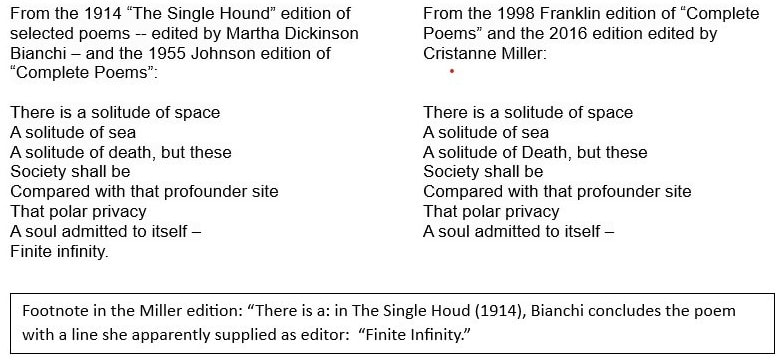Below I’ve posted two versions of the poem – one from 1914 and 1955 editions; the other from 1998 and 2016 editions. The key difference between them is the final line – “Finite Infinity” – seems to have been added to the poem by the 1914 editor Martha Dickinson Bianchi.
While exploring this poem, I also stumbled upon a couple of interesting articles.
In the first, entitled “That Polar Privacy: Emily Dickinson’s Locked Room,” the blogger states, “It seems like a good time…to read Emily Dickinson” – and that’s particularly interesting because the post was published in July 2020, in the midst of the COVID “lockdown.”
The article begins like this:
“Self-isolation, social distancing, quarantine – solitude and its protocols have become part of our everyday consciousness and language. Of course, the solitudes of COVID-19 are not strictly voluntary. We none of us chose to be confined to our homes, separated from our colleagues and friends and the world at large. But we may nonetheless have felt some blurring during these months of the line separating voluntary from involuntary solitude.”
Talk about one being in the heart of “polar privacy.”
The complete article is HERE.
The second post also addresses the solitude in the time of COVID: “A Solitude of Space: Studying Emily Dickinson in the time of COVID-19.”
The blogger recounts what it felt like when her class at Wellesley, “ENG 357: The World of Emily Dickinson,” suddenly went digital; as the lockdown began, she received this message from her professor:
“I’m sure it has occurred to you that our interiors—our bounded environments, however large or small, and wherever we find ourselves—are suddenly our entire worlds; our predicament or opportunity mirrors Dickinson’s.”
The blogger added, “It felt to many of us that Dickinson was teaching us how to live richly within the boundaries of our new world.”
To access the complete article, click HERE.

 RSS Feed
RSS Feed
